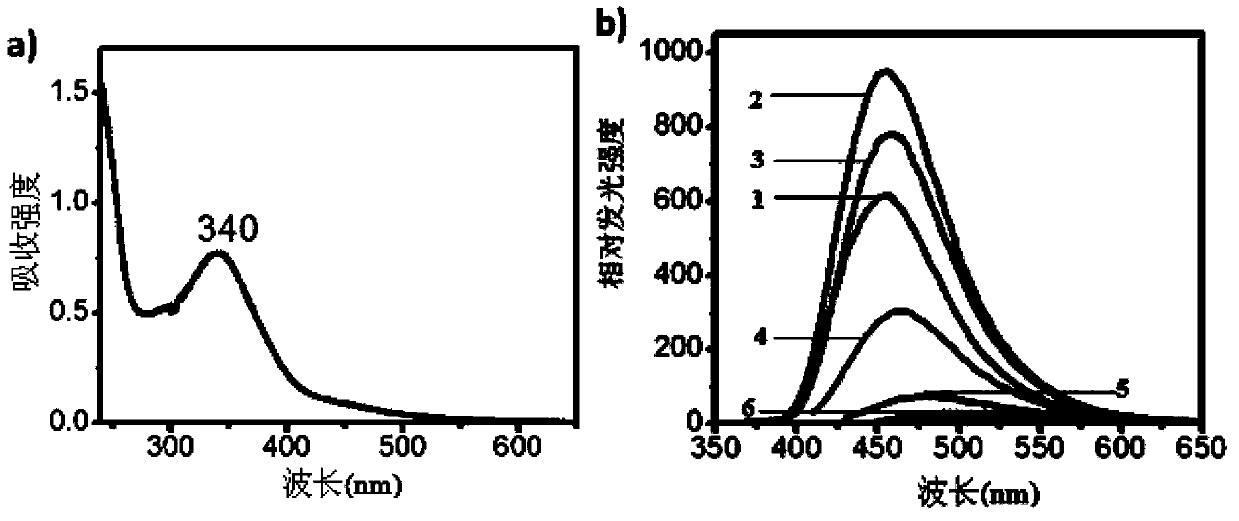Carbon nano point with high fluorescence quantum efficiency and preparation method thereof
A fluorescent quantum and carbon nanodot technology, applied in nanocarbon, nanotechnology, nanooptics and other directions, can solve the problems of low fluorescent quantum efficiency of carbon nanodots, poor water solubility, time-consuming and labor-intensive, etc. The effect of production, broadening the scope of application and low cost
- Summary
- Abstract
- Description
- Claims
- Application Information
AI Technical Summary
Problems solved by technology
Method used
Image
Examples
Embodiment 1
[0040] (1) Put 2.1 g of oxalic acid and 2.5 g of diethylene triamine into a round bottom flask, mix well to obtain a mixture;
[0041] (2) Heat the mixture at 170°C for 16 hours to obtain a crude product;
[0042] (3) After the crude product is naturally cooled to room temperature, acetone is added, precipitated, washed, the resulting precipitate is separated by a centrifuge, and the precipitate is placed in a dialysis bag (molecular weight cut-off: 3.0KDa), and dialyzed with water for two days , Change the water every 6h to remove small molecules;
[0043] (4) Freeze-dry the solution in the dialysis bag to obtain a yellow-brown solid, that is, carbon nanodots.
[0044] The prepared carbon nano-dots are solid, which is easy to store, and has very good solubility in water. The aqueous solution of carbon nano-dots is very stable and stored at room temperature for one year without precipitation or aggregation.
Embodiment 2
[0046] (1) Add 1.8 g of glycine and 7.5 g of diethylenetriamine into a round bottom flask, mix well to obtain a mixture;
[0047] (2) Heat the mixture at 175°C for 10 hours to obtain a crude product;
[0048] (3) After the crude product is naturally cooled to room temperature, acetone is added, precipitated, washed, the resulting precipitate is separated by a centrifuge, and the precipitate is placed in a dialysis bag (molecular weight cut-off: 3.0KDa), and dialyzed with water for two days , Change the water every 6h to remove small molecules;
[0049] (4) Freeze-dry the solution in the dialysis bag to obtain a yellow-brown solid, which is a carbon nanodot.
[0050] The prepared carbon nanodots are solid, which is convenient for storage, and has very good solubility in water. The aqueous solution of carbon nanodots is very stable and stored at room temperature for one year without precipitation and aggregation.
Embodiment 3
[0052] Combine figure 1 Illustrative Example 3
[0053] (1) Put 2.1g of citric acid and 4.5g of diethylenetriamine into a round bottom flask, mix well to obtain a mixture;
[0054] (2) Heat the mixture at 165°C for 6 hours to obtain a crude product;
[0055] (3) After the crude product is naturally cooled to room temperature, acetone is added, precipitated, washed, the resulting precipitate is separated by a centrifuge, and the precipitate is placed in a dialysis bag (molecular weight cut-off: 3.0KDa), and dialyzed with water for two days , Change the water every 6h to remove small molecules;
[0056] (4) Freeze-dry the solution in the dialysis bag to obtain a yellow-brown solid, which is a carbon nanodot.
[0057] The carbon nanodots of Example 3 are dissolved in water, and they are colorless and transparent under natural light irradiation. After irradiation with 365nm light, such as figure 1 As shown, the carbon nanodots are blue in the aqueous solution, indicating that the carbon na...
PUM
 Login to View More
Login to View More Abstract
Description
Claims
Application Information
 Login to View More
Login to View More - R&D
- Intellectual Property
- Life Sciences
- Materials
- Tech Scout
- Unparalleled Data Quality
- Higher Quality Content
- 60% Fewer Hallucinations
Browse by: Latest US Patents, China's latest patents, Technical Efficacy Thesaurus, Application Domain, Technology Topic, Popular Technical Reports.
© 2025 PatSnap. All rights reserved.Legal|Privacy policy|Modern Slavery Act Transparency Statement|Sitemap|About US| Contact US: help@patsnap.com



